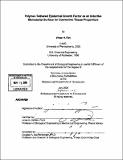| dc.contributor.advisor | Linda G. Griffith. | en_US |
| dc.contributor.author | Fan, Vivian H. (Vivian Hanbing) | en_US |
| dc.contributor.other | Massachusetts Institute of Technology. Biological Engineering Division. | en_US |
| dc.date.accessioned | 2007-07-18T13:16:27Z | |
| dc.date.available | 2007-07-18T13:16:27Z | |
| dc.date.issued | 2006 | en_US |
| dc.identifier.uri | http://hdl.handle.net/1721.1/37959 | |
| dc.description | Thesis (Ph. D.)--Massachusetts Institute of Technology, Biological Engineering Division, September 2006. | en_US |
| dc.description | "July 2006." | en_US |
| dc.description | Includes bibliographical references (leaves 123-137). | en_US |
| dc.description.abstract | Connective tissue progenitors (CTP) can act as a pluripotent source of reparative cells during injury and therefore have great potential in regenerative medicine and tissue engineering. However, the response of CTP to most growth factors and cytokines is unknown. Many envisioned applications of CTP, such as treating large defects in bone, involve in vivo implantation of CTP attached to a scaffold, a process that creates an acute inflammatory environment that may be hostile to CTP survival. This project entails the design of a two-component polymeric implant system to aid in the healing process of bony defects by influencing cell behaviors at the implant site through the covalent modification of the implant surface with selected ligands. We investigate cellular responses of CTP on a biomaterial surface covalently modified with epidermal growth factor (EGF) and find that surface-tethered EGF (tEGF) promotes both cell spreading and survival more strongly than saturating concentrations of soluble EGF. By sustaining MEK-ERK signaling, tEGF increases the contact of CTP with an otherwise moderately adhesive synthetic polymer and confers resistance to apoptosis induced by the proinflammatory cytokine, FasL. | en_US |
| dc.description.abstract | (cont.) We confirm that these signaling, spreading, and apoptotic responses are conserved across three sources of CTP: an hTERT-immortalized human mesenchymal stem cell (MSC) line, primary porcine bone-marrow CTP, and primary human bone-marrow-derived CTP. We conclude that tEGF may offer a protective advantage to CTP in vivo during acute inflammatory reactions to tissue engineering scaffolds. The tEGF-modified polymers described here could be used together with structural materials to construct CTP scaffolds for the treatment of hard-tissue lesions, such as large bony defects. | en_US |
| dc.description.statementofresponsibility | by Vivian H. Fan. | en_US |
| dc.format.extent | 137 leaves | en_US |
| dc.language.iso | eng | en_US |
| dc.publisher | Massachusetts Institute of Technology | en_US |
| dc.rights | MIT theses are protected by copyright. They may be viewed, downloaded, or printed from this source but further reproduction or distribution in any format is prohibited without written permission. | en_US |
| dc.rights.uri | http://dspace.mit.edu/handle/1721.1/7582 | |
| dc.subject | Biological Engineering Division. | en_US |
| dc.title | Polymer-tethered epidermal growth factor as an inductive biomaterial surface for connective tissue progenitors | en_US |
| dc.title.alternative | Polymer-tethered EGF as an inductive biomaterial surface for CTP | en_US |
| dc.type | Thesis | en_US |
| dc.description.degree | Ph.D. | en_US |
| dc.contributor.department | Massachusetts Institute of Technology. Department of Biological Engineering | |
| dc.identifier.oclc | 144608564 | en_US |
